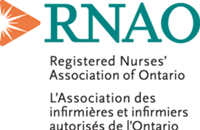Low-cost interventions could save people's limbs, lives, and millions of Ontario's health-care dollars
TORONTO, Apr. 12, 2016 /CNW/ - Each year, almost 2,000 Ontarians are forced to endure a diabetes-related amputation, 85 per cent of whom could be spared from this terrible suffering. In addition to the human cost is the direct health system cost of a diabetic foot amputation, estimated at about $70,000 per patient's limb. The overall annual cost to the health system is $140 million dollars. That's why nurses, doctors, other health professionals and patients are heading to Queen's Park today.
The Canadian Association of Wound Care (CAWC) and the Registered Nurses' Association of Ontario (RNAO) are bringing recommendations to Ontario MPPs on how to improve the quality of life of people who suffer from complications related to diabetes, and save millions of dollars in the process.
People with diabetes are at high risk for foot ulcers because many of them develop a condition that results in damage to the nerves. The nerve damage inhibits a person's ability to feel sensation in their feet. As a result, bruises, bumps and even cuts to their feet can go unnoticed. They may fail to seek help until the problem is severe, leaving them with a foot ulcer that is difficult to heal, may be very deep (to the bone) and/or infected. Once this happens, RNAO and the CAWC say it's too late and they are at high risk for amputation.
"Diabetes-related foot complications are a costly problem for the system that has devastating effects on patients and their families," says Mariam Botros, a chiropodist and CAWC Executive Director. "The good news is that these are largely preventable. Minimal investment in this area can save limbs and lives, not to mention millions in health-care dollars annually."
RNAO and CAWC have a number of resources for the public and for health practitioners that help prevent and better treat diabetic foot ulcers. RNAO has developed research-based guidelines and teaching tools directly related to diabetic foot ulcers. Together, they are urging swift action in four areas:
- Provide universal access and free preventative foot care services, including offloading devices - to relieve pressure on the feet - for all Ontarians living with diabetes.
- Ensure all Ontarians with diabetes have at least one annual foot assessment by a qualified health professional who can refer to a specialist as needed.
- Adopt an Ontario-wide interprofessional approach to diabetic foot care by establishing at least one multidisciplinary diabetes foot care team per Local Health Integration Network (LHIN) that supports timely access to care.
- Publish reliable data related to foot care for those with diabetes on an annual basis.
"Foot ulcers can be devastating. Implementing our recommendations will substantially increase a person's quality of life and improve their mobility. We are talking about an investment of $100 on average per patient. Compare that to the cost of an amputation at about $70,000, and you have to wonder why the government hasn't already acted," says RNAO's CEO Dr. Doris Grinspun, who adds offloading devices and regular preventative care to avoid pressure ulcers - and ultimately, limb amputations - should be a mandatory program for all enlightened health systems across the country. "If the ministry is serious about putting patients first, let's start by preventing amputations. Our recommendations will radically change the way health professionals approach the care of people that today are forced to suffer."
Facts about Diabetes-related Foot Complications
- 1.53 million people in Ontario have diabetes.
- The CDA estimated that up to 25,000 of them will be diagnosed with a diabetic foot ulcer in 2016.
- Without timely and appropriate care, foot ulcers in persons with diabetes can result in amputation of part or all of their foot.
- Approximately 2,000 Ontarians will have a lower limb amputation this year.
- Ontario will see 800 premature deaths in people with diabetes who have an amputation.
- The Ontario government currently spends between $320 million and $400 million for diabetes-related foot ulcer treatment - including $140 million for amputations.
- 85 per cent of amputations are preventable.
Sources: Canadian Diabetes Association and Ontario Health Technology Advisory Committee
RNAO is the professional association representing registered nurses, nurse practitioners, and nursing students in Ontario. Since 1925, RNAO has advocated for healthy public policy, promoted excellence in nursing practice, increased nurses' contribution to shaping the health-care system, and influenced decisions that affect nurses and the public they serve. For more information about RNAO, visit our website at RNAO.ca or follow us on Facebook and Twitter.
The Canadian Association of Wound Care (CAWC) is Canada's leading organization for wound-related knowledge mobilization. Established in 1995, the non-profit association is dedicated to the advancement of wound prevention and care to improve the health of Canadians. The association focuses efforts in four key areas: 1) professional education, 2) public advocacy, awareness and education, 3) research and 4) partnerships to support the CAWC's goals of improving patient outcomes. For more information, please visit our website at www.cawc.net and follow us on Twitter and Facebook.
SOURCE Registered Nurses' Association of Ontario

Mariam Botros, Executive Director, Canadian Association of Wound Care, [email protected]; Doris Grinspun, Chief Executive Officer, Registered Nurses' Association of Ontario, [email protected]; For media calls, please contact: Marion Zych, Director of Communications, Registered Nurses' Association of Ontario, [email protected], 647-406-5605 (cell), 416-408-5605 (office)

Share this article